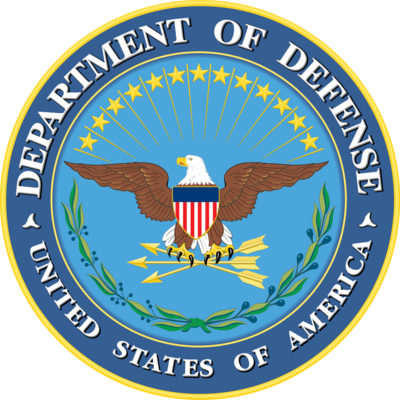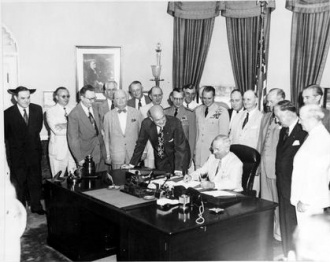Difference between revisions of "US/Department/Defense"
(fix motto) |
(DISA) |
||
| Line 11: | Line 11: | ||
|logo_width=400px | |logo_width=400px | ||
|leader=United States Secretary of Defense | |leader=United States Secretary of Defense | ||
| − | |subgroups=U.S. Department of the Army, U.S. Department of the Navy, U.S. Department of the Air Force, | + | |subgroups=U.S. Department of the Army, U.S. Department of the Navy, U.S. Department of the Air Force, Defense Intelligence Agency, National Security Agency, Defense Information Systems Agency, National Geospatial-Intelligence Agency, National Reconnaissance Office, Defense Advanced Research Projects Agency, Defense Logistics Agency, Missile Defense Agency, Defense Threat Reduction Agency, Pentagon Force Protection Agency, National Defense University, National War College |
|precedingGroups = U.S. Department of War, U.S. Department of the Navy | |precedingGroups = U.S. Department of War, U.S. Department of the Navy | ||
}} | }} | ||
Revision as of 16:26, 28 July 2015
 | |
| Formation | August 10, 1949 |
| Parent organization | US |
| Headquarters | The Pentagon |
| Type | military |
| Subgroups | • U.S. Department of the Army • U.S. Department of the Navy • U.S. Department of the Air Force • Defense Intelligence Agency • • Defense Information Systems Agency • National Geospatial-Intelligence Agency • • • Defense Logistics Agency • Missile Defense Agency • Defense Threat Reduction Agency • Pentagon Force Protection Agency • National Defense University • National War College |
History

The United States Congress created the War Department in 1789 and the Navy Department in 1798. The secretaries of each of these departments reported directly to the President as cabinet-level advisors.
In a special message to Congress on December 19, 1945, President Harry Truman proposed creation of a unified department of state defense, citing both wasteful military spending and inter-departmental conflicts. Deliberations in Congress went on for months focusing heavily on the role of the military in society and the threat of granting too much military power to the executive.[1]
Criticism
The DoD has faced criticism about its program of distributing surplus military equipment to US police forces. In 2014, Los Angeles Unified school police officials returned three grenade launchers to the military, although they kept the M-16 rifles and the armored vehicle.[2]
An event carried out
| Event | Location | Description |
|---|---|---|
| REX-84 | US | Scenario and drill developed by the United States federal government to detain large numbers of United States residents deemed to be "national security threats" in the event that the president declared a National Emergency (martial law). |
An example
| Page name | Description |
|---|---|
| DARPA |
References
- ↑ Hogan, Michael J. (2000). A cross of iron: Harry S. Truman and the origins of the national security state, 1945-1954. Cambridge University Press. pp. 37–38. ISBN 978-0-521-79537-1.Page Module:Citation/CS1/styles.css must have content model "Sanitized CSS" for TemplateStyles (current model is "Scribunto").
- ↑ http://www.latimes.com/local/lanow/la-me-schools-weapons-20140917-story.html